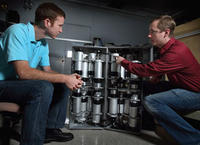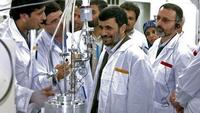-
Israel conducted tests to assess the impact of dirty bombs
Between 2010 and 2014, Israeli scientists at the Dimona nuclear reactor conducted a series of experiments, under the code name “Green Field,” to examine the consequences of a dirty-bomb explosion in Israel. The purpose of the experiments was defensive – to measure the likely effect of a dirty bomb and evaluate countermeasures. The experiments did not evaluate to offensive potential of a dirty bomb.
-
-
Inventing a stronger radiological waste bag for extra protection
Researchers at the Savannah River National Laboratory found out that a radiological waste bag was not lasting as long as he would like, so they set about inventing a new one, creating a “double-ply” waste containment bag capable of better containing nuclear waste. Much like a household garbage bag is used to protect waste from leaking into a garbage can, special radiological waste bags are used to keep radiation from leaking into a storage container.
-
-
Nuclear forensics science helps thwart terrorist use of nuclear materials
A nuclear weapon in the hands of terrorists is the stuff of nightmares, especially for U.S. agencies charged with preventing a devastating attack. When security or law enforcement agents confiscate nuclear or radiological weapons or their ingredients being smuggled domestically or internationally, they must quickly trace them back to their source. This is where the science of nuclear forensics comes in. With funding from DHS, Oregon State University has launched a new graduate emphasis in nuclear forensics in OSU’s Department of Nuclear Engineering and Radiation Health Physics.
-
-
In South Africa, bomber of apartheid era nuclear power plant is a hero, not a terrorist
In December 1982, Rodney Wilkinson planted four bombs that caused $519 million in damages at the Koeberg nuclear power plant north of Cape Town, South Africa. The attack, which many believe to be the most ambitious and successful terror attack against a nuclear facility, remains a symbol of African National Congress (ANC) war against South Africa’s then-apartheid government. The 1982 Koeberg assault, however, and a 2007 raidby two yet-to-be-identified armed groups on South Africa’s Pelindaba nuclear research site, are at the root of U.S. concerns about the safety of South Africa’s roughly 485 pounds stockpile of highly enriched uranium.
-
-
Improving plutonium identification
Researchers have developed a new kind of sensor that can be used to investigate the telltale isotopic composition of plutonium samples — a critical measurement for nuclear non-proliferation efforts and related forensics, as well as environmental monitoring, medical assays, and industrial safety. The novel device, based on “transition edge” sensor technology developed at NIST, is capable of ten times better resolution than all but the most expensive and time-consuming of current methods, and reduces the time needed for sample analysis from several days to one day.
-
-
Russian secret agents implicated in nuclear poisoning of a critic of Putin
Alexander Litvinenko, a Russian dissident and a vocal critic of President Vladimir Putin, died in London on 23 November 2006 after suffering from radioactive polonium-210 poisoning. An inquest has established that on 1 November 2006 he ingested large quantities of the radioactive material, surreptitiously put in his tea by two agents of the Russian Federal Protective Services. A nuclear expert testifying at the inquest said that less than a millionth of a gram of polonium would be enough to kill a human being.
-
-
Sandia Lab’s mobile neutron imager shines in urban emergency response exercise

A nuclear device has been hidden in a high-rise building in a major metropolitan area. Emergency responders have intelligence that narrows down the location to a single city block, but it is not safe to search door-to-door. Can they identify the exact location of the device quickly without the culprits realizing a search is on? The answer is a definite yes. Sandia Lab’ mobile imager of neutrons for emergency responders (MINER) system did just that at an emergency response exercise in downtown Chicago earlier this year. The exercise used a sealed laboratory radiation source that mimics the radioactive signature of more nefarious material.
-
-
Transparent nanoscintillators for radiation detection in homeland security, medical safety
Researchers say recently identified radiation detection properties of a light-emitting nanostructure built in their lab could open doors for homeland security and medical advances. The researchers describe a new method to fabricate transparent nanoscintillators by heating nanoparticles composed of lanthanum, yttrium and oxygen until a transparent ceramic is formed. A scintillator refers to a material that glows in response to radiation.
-
-
New device improves radiation detection
In a move that could have important implications for national security, researchers have created a very sensitive and tiny detector that is capable of detecting radiation from various sources at room temperature. The detector is eight to nine orders of magnitude —100 million to as high as 1 billion — times faster than the existing technology. The researchers sought to utilize the exceptional electronic carrier properties of graphene to create the photo detector device. Graphene is made of carbon atoms that are arranged in a honeycomb-like geometrical structure (the diameter of a human hair is 300,000 times thicker than a two-dimensional sheet of graphene).
-
-
Tennessee man pleads guilty to attempting to extort a nuclear contractor
Adam Winters, 26, of Robbins, Tennessee, has pleaded guilty in a $2.5 million extortion case involving Babcock and Wilcox, a managing contractor at the Y-12 National Security Complex in Oak Ridge. According to Oak Ridge Today, Winters sent the contractors an e-mail on 8 May, threatening to injure their reputation by publishing roughly 1,200 slides containing evidence from nuclear testing, including the amount of radiation used on animals.
-
-
Iran wants to expand its uranium enrichment capacity

Iran’s Supreme Leader Ayatollah Ali Khamenei said on Tuesday that Iran would need significantly to increase its uranium enrichment capacity for future energy needs, dealing a setback to negotiations between the country and world powers.
-
-
Los Alamos lab admits mishandling toxic waste, causing repository radiation leak
In a letter addressed to the New Mexico Environment Department (NMED), lab officials at Los Alamos National Laboratory (LANL) have admitted to mishandling toxic waste shipped to the Waste Isolation Pilot Plant (WIPP) in Carlsbad, New Mexico, the nation’s only permanent repository for plutonium-contaminated waste from government nuclear facilities.
-
-
Game of marbles inspires nuclear-inspection protocol

Modern cryptography combined with simple radiation detectors could allow nuclear-weapons checks to be carried out with almost complete security. That is the conclusion of scientists in the United States, who have used computer simulations to show how a beam of neutrons can establish the authenticity of a nuclear warhead without revealing any information about that weapon’s composition or design.
-
-
Engineering nuclear nonproliferation

University of Virginia engineering professor Houston Wood’s career demonstrates the important role that engineers can play in making the world a safer place. For more than two decades, Wood has helped governments determine whether nuclear programs in other parts of the world are being dedicated to peaceful or military purposes. In recent years, Wood has been working to determine the break-out time that Iran would require to develop a nuclear weapon if it stopped allowing the International Atomic Energy Agency IAEA) to inspect its nuclear facilities.
-
-
WIPP radiation leak investigation focuses on Los Alamos National Laboratory (LANL)
The U.S. Department of Energy’s (DOE) accident investigation team reviewing the leak at the Waste Isolation Pilot Plant (WIPP) in Carlsbad, New Mexico has turned its focus to the Los Alamos National Laboratory (LANL). Communications between LANL and EnergySolutions, the contractor which packaged LANL’s waste for shipment to WIPP, have revealed that EnergySolutions switched from using an inorganic clay-based absorbent in the storage drums to an organic wheat-based mixture. Scientists are now trying to determine whether the switch to the organic substance is to blame for the chemical reaction that led to the explosion.
-
- All
- Regional
- Water
- Biometrics
- Borders/Immig
- Business
- Cybersecurity
- Detection
- Disasters
- Government
- Infrastructure
- International
- Public health
- Public Safety
- Communication interoperabillity
- Emergency services
- Emergency medical services
- Fire
- First response
- IEDs
- Law Enforcement
- Law Enforcement Technology
- Military technology
- Nonlethal weapons
- Nuclear weapons
- Personal protection equipment
- Police
- Notification /alert systems
- Situational awareness
- Weapons systems
- Sci-Tech
- Sector Reports
- Surveillance
- Transportation
Advertising & Marketing: advertise@newswirepubs.com
Editorial: editor@newswirepubs.com
General: info@newswirepubs.com
2010-2011 © News Wire Publications, LLC News Wire Publications, LLC
220 Old Country Road | Suite 200 | Mineola | New York | 11501
Permissions and Policies
Editorial: editor@newswirepubs.com
General: info@newswirepubs.com
2010-2011 © News Wire Publications, LLC News Wire Publications, LLC
220 Old Country Road | Suite 200 | Mineola | New York | 11501
Permissions and Policies
